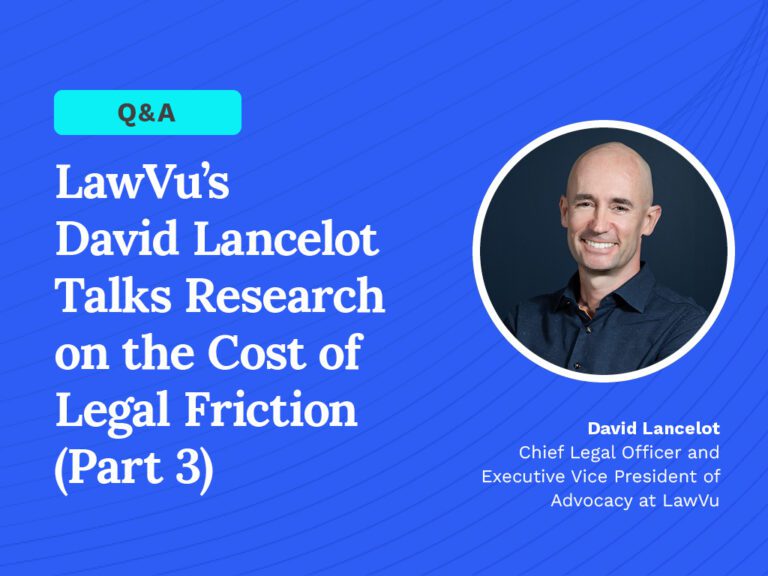LawVu’s David Lancelot Talks Research on the Cost of Legal Friction (Part 3)
October 27, 2025

With 20+ years’ experience leading international in-house legal teams, David Lancelot is Chief Legal Officer and Executive Vice President of Advocacy at LawVu. He is also an Adjunct Professor at the University of Florida College of Law, teaching International In-House Legal Leadership. Previously, he held senior legal leadership roles across technology, ecommerce, and media.
This Q and A is the third part of a three-part conversation with David Lancelot, Chief Legal Officer and Executive Vice President of Advocacy at LawVu, about “Legal Friction: The Real Cost to Your Business.” The research is based on an International Data Corporation (IDC) survey of more than 350 business and legal leaders across the United States, the United Kingdom, and Australia. It focuses on the operational drag caused by inefficient legal processes and fragmented workflows within legal teams and between legal and business partners. You can read the first part of the interview here and the second part here.
Outside counsel spend is often higher than it needs to be due to internal inefficiencies. What strategies could legal departments adopt to right-size their workload and reduce unnecessary reliance on external law firms?
David Lancelot: This concept—and the related statistics in the research, which indicate that one-sixth of legal work is outsourced due to bandwidth constraints within the internal team and business partners outsourcing work due to legal unavailability—jumps out at me. I attend many conferences, and when the topic is billing, the discussion often gets stuck on bill review and partner rates. But we rarely ask the deeper question: why are we externalizing this work in the first place?
If it’s lower-value work, like a routine commercial contract review that isn’t particularly strategic, why send it to a law firm at all? In fact, why are we even doing it? On the other end, if it’s high-value, strategic work, why isn’t it handled in-house? Of course, there’s usually a middle ground where outside counsel makes sense, but too often, legal departments default to outsourcing without considering their operational perspective.
The more effective approach is to minimize internal workload as much as possible. Take low-value work off legal’s plate through templates, workflows, policies, or automation. Sometimes the best answer is simply not doing the work at all because the risk doesn’t justify it. Then, with the bandwidth you’ve freed up, re-examine the strategic work you’re sending out. Could some of it be handled internally? Could you use an ALSP, or move the work to a different jurisdiction where it’s more cost-effective? Too often, teams are so busy keeping up with day-to-day tasks that they never take the time to think strategically. And that’s what really drives the spend.
The research indicates business leaders see the need for technology, but legal teams often struggle to get investment. How can general counsel and legal operations leaders build a compelling case for the C-suite to support sustained investment in legal transformation?
David Lancelot: The first thing is relationships. You need to build trust with finance and strategy leaders and be clear about your purpose. Legal isn’t just here to manage risk; we’re here to be a competitive advantage to the business. That means transforming into a modern in-house function that drives strategic objectives.
But you can’t make that case in legal jargon. The CFO doesn’t want long dictums. You need data. Numbers. Charts. That starts with capturing workload data, even manually at first, so you can show what’s coming in, how it’s being handled, and where the pain points are. It may not scale immediately, but it establishes the baseline you need.
From there, you build the business case: here’s where we are, here’s where we could be, and here’s what that difference means in terms of cost savings, faster processes, and reduced risk. And the data backs it up. As I’ve mentioned before, IDC research shows an average of 11% of revenue is delayed due to legal friction. That’s a very powerful figure to put in front of a CFO.
Looking forward, what does a frictionless legal function look like in your view, and what steps should legal departments take today to move toward that vision?
David Lancelot: First off, I don’t think a truly “frictionless” legal function exists. There will always be some friction. But it’s about minimizing it as much as possible. Richard Susskind tells a story I like: he once asked brain surgeons what a frictionless experience for patients would be. They said, “robotic surgery, minimally invasive.” His response was, “No, the patient never wants to meet you at all.”
The same applies to legal. A frictionless experience is one where the business only engages with legal when it truly adds value. Everything else should be automated, streamlined, or eliminated from the process. The best customer service is when you don’t need to call customer service.
Practically, that means adopting an operational mindset and modern technology. Build portals where business users can submit third-party papers, implement workflows that route them automatically, and apply risk matrices to ensure that only significant issues are brought to the attention of legal. Most of what crosses our desks doesn’t require a deep review. The problem is that we lack the processes and tools to handle it differently.
My vision is this: when the leadership team meets, they ask, “Where’s the product lawyer?” because they can’t start without legal in the room. That’s when legal isn’t slowing the business down at the end; it’s accelerating it from the beginning. That’s how you spot the icebergs before they appear on the radar. That’s what a low-friction legal function looks like.
Read the first part of the interview here and the second part here.
Must read intelligence for general counsel
Subscribe to the Daily Updates newsletter to be at the forefront of best practices and the latest legal news.
Daily Updates
Sign up for our free daily newsletter for the latest news and business legal developments.




